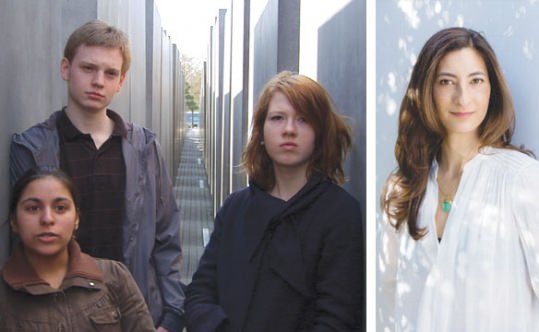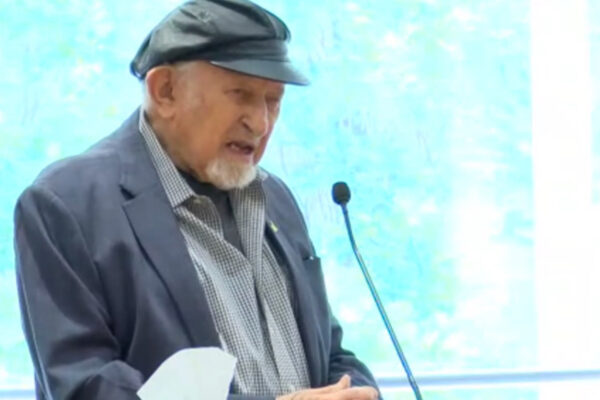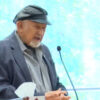
Left: German teenagers at the Holocaust Memorial in Berlin in “March of the Living.” Photo courtesy of Jessica Sanders/”March of the Living” Right: Filmmaker Jessica Sanders. Photo courtesy of Big Time PR
Oscar-nominated filmmaker Jessica Sanders went to Brazil to document Carnival and samba music. After unexpected detours to Auschwitz and Israel, however, she ended up making a movie about something much more serious: an event that exemplifies survival and affirmation.
All told, Sanders’ 76-minute documentary, “March of the Living” — released on video on demand on June 28 — took Sanders to five countries, including Brazil, where it was produced.
“March of the Living” follows a group of teens and Holocaust survivors who travel to Poland to re-create the death march between Auschwitz and Birkenau as part of the 2008 International March of the Living. Every year on Yom HaShoah, thousands of teens and survivors participate in the march, making the approximately 2-mile journey between the camps on foot before traveling on to Israel. The gathering is an opportunity to remember those who were killed during the Shoah and to educate future generations. Since the inaugural event in 1988, more than 220,000 people from 52 countries have participated.
Brazilian producer L.G. Tubaldini Jr. approached Sanders with the idea of looking at the Holocaust from an international perspective, and the idea was too intriguing to pass up. The director expects her film, which was shot in four languages, to get people to view the Holocaust from a unique viewpoint.
“This was such an unexpected film for me to make,” said Sanders, a Los Angeles native who attended Harvard-Westlake School. “We have no archival footage. We have a contemporary score from an awesome Brazilian composer. We had one American associate producer, and everybody else was Brazilian. From what I understood, there had never been a contemporary take on the Holocaust story. I thought I could do something different.”
Sanders, whose father is Jewish, interviewed a group of Los Angeles area high school students from Harvard-Westlake, New Community Jewish High School (now deToledo High School) and Milken Community Schools, as well as teens from Brazil and Berlin. “March of the Living” shows these young men and women visiting the death camps alongside several survivors who experienced atrocities in these camps when they were children or teenagers during World War II.
Although the film uses no archival wartime footage, “March of the Living” tracks the marchers into barracks and rooms that display horrific reminders of what the Jews experienced in the camps. Museum rooms display giant mounds of human hair, discarded shoes and the incinerated ashes of murdered people. The teenagers listen, often in tears, as tour guides and survivors recount horrific stories of life in the camp. Many of them note that from the outside, the death camps are green and look almost like they could be college campuses.
According to Sanders, the students she chose to track were meant to be a diverse group — upper-middle class students from privileged backgrounds in Los Angeles sharing a journey of discovery with working-class, less social media-savvy kids from Brazil and Berlin.
“I tried to find different kinds of Jewish experiences and put them out there,” Sanders said. “A lot of these kids have now graduated college and are doing human rights work. The march impacted their lives.”
Among the Los Angeles teens appearing in the film is Dani, who is of Polish descent. She says that she can’t think of her family’s country of ancestry without remembering the Holocaust.
“I could have probably survived the Holocaust looking like this. I’m almost the perfect Aryan,” the blond, blue-eyed Dani says in the film. “So, ‘Ha!’ in Hitler’s face. There are Jews who look like me.”
Sanders said she went through a period of her childhood when she was obsessed with the Holocaust, particularly with children who had survived the experience. The writer-director added that several of her previous films touched on issues of imprisonment and social justice. Her award-winning 2005 documentary, “After Innocence,” chronicles the plight of men who have been released from prison after new evidence led to their exoneration. She is currently working on a feature film, “Picking Cotton,” that follows up one of the stories from “After Innocence.”
“When I look back, it kind of makes sense that I ended up on this film,” said Sanders, whose short-form 2001 documentary, “Sing!” was nominated for an Oscar.
Sidonia Lax, one of the Los Angeles area survivors featured in “March of the Living,” has participated in 11 Marches of the Living and hopes to do at least one more. A foundation set up in her name helps students who lack the financial resources to attend the march.
Lax spent three months in an underground bunker in her apartment in Przemysl, Poland, before she was captured and taken to various labor camps. She was later transferred to Auschwitz and ultimately to Elsnig, a Buchenwald sub-camp near Torgau, Germany, where she worked in an ammunition factory. Both of her parents were killed in the war.
Lax, who recently celebrated her 89th birthday, calls the march an amazing experience for the teens. Passing on the story of her experience, she said, is “my legacy.”
“It’s the only time they have a chance to see a survivor’s face and listen to a living person,” Lax said. “I tell them that, ‘Yesterday was history, today is a gift for you and tomorrow is a mystery.’ That means now it’s very important that they listen to the stories, remember them, and relate them to the future generations because survivors will not be here much longer.”
Originally published HERE







